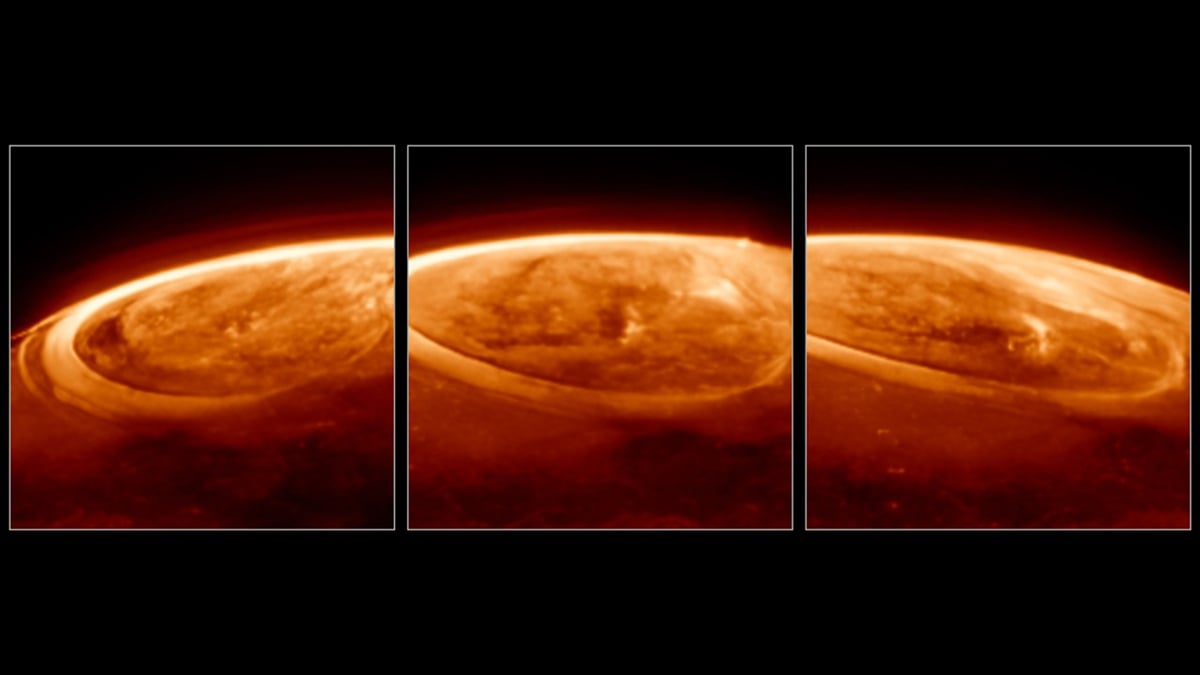
Jupiter is a world of extremes. It’s the largest planet in our solar system, has the fastest rotation, and wields a powerful magnetic field. Thanks to NASA’s James Webb Space Telescope (JWST), we have the clearest, most detailed view of its vibrant auroras. Similar to Earth’s northern and southern lights, these glowing polar lights reveal new secrets about Jupiter’s atmosphere and magnetosphere. The new JWST images, released on May 12, 2025, offer both beauty and science. They show Jupiter’s upper atmosphere bathed in infrared light. The planet’s auroras appear as glowing arcs, ribbons, and ovals circling its poles. But these are not just pretty pictures. Scientists are using this data to understand how Jupiter interacts with the Sun and how its magnetosphere shapes the planet’s weather and chemistry.
Capturing Jupiter’s auroras
JWST captured these observations using its Near-Infrared Camera (NIRCam) on December 25, 2023. The telescope pointed toward Jupiter’s poles and imaged the auroras in incredible detail. These auroras are created when charged particles, mostly electrons, slam into Jupiter’s upper atmosphere. These particles excite hydrogen molecules, which then emit infrared light.
This process produces the glowing features we see in JWST’s images. Scientists focused on emissions from a special molecule: the trihydrogen ion (H₃⁺). This ion forms when high-energy electrons hit molecular hydrogen. It plays a key role in Jupiter’s thermosphere, the hot, upper layer of the atmosphere. JWST is sensitive enough to detect these faint signals, even though Jupiter is extremely bright. Thanks to its infrared vision, the telescope could see what others couldn’t.

What makes Jupiter’s auroras so unique?
Jupiter’s auroras are hundreds of times more powerful than Earth’s. That’s because Jupiter has the strongest magnetic field of any planet in our solar system. It’s about 20,000 times stronger than Earth’s. This field traps particles from the solar wind and its volcanic moon, Io, funneling them toward the poles. The auroras are present almost all the time. But their intensity can vary, especially during solar storms. JWST’s data revealed that the H₃⁺ emission was far more variable than expected. This was a surprise to scientists.
It suggests that Jupiter’s upper atmosphere responds quickly and dramatically to changes in the space environment. These changes may come from bursts of particles, waves in the magnetic field, or other dynamic processes.

NASA, ESA, CSA, STScI, Ricardo Hueso (UPV), Imke de Pater (UC Berkeley), Thierry Fouchet (Observatory of Paris), Leigh Fletcher (University of Leicester), Michael H. Wong (UC Berkeley), Joseph DePasquale (STScI), Jonathan Nichols (University of Leicester), Mahdi Zamani (ESA/Webb)
A closer look at the data
JWST’s NIRCam data provided spectral and spatial information. Scientists could measure the temperature and density of the H₃⁺ ions. They found that the auroras were not uniform. In some regions, the temperature reached over 1,000 kelvin (about 727°C or 1340°F). In others, it was much cooler. The density of H₃⁺ also varied by location and time. This points to complex chemistry and energy flows in Jupiter’s thermosphere.
Another key finding was the relationship between Jupiter’s magnetic field lines and the aurora shapes. The auroras seemed to follow the structure of the field. Some arcs stretched far from the poles, showing how the magnetic field connects distant regions. This helps researchers understand how energy travels through Jupiter’s magnetosphere.

JWST’s advantage
Before JWST, telescopes like Hubble and ground-based infrared observatories had studied Jupiter’s auroras. But none had JWST’s clarity or sensitivity. Hubble sees mostly in ultraviolet and visible light. JWST works in the infrared, which is perfect for detecting H₃⁺ emissions. It can also peer through clouds and haze that block shorter wavelengths. In these latest observations, JWST imaged Jupiter’s entire disk. The auroras formed bright ovals at the top and bottom, while the middle remained dark in infrared. This contrast helps separate auroral features from the planet’s thermal glow.
These new images also showcase JWST’s power as a telescope. Designed to peer into the early universe, it also excels at exploring nearby planets. Its sensitivity and resolution are unmatched in the infrared. This opens doors to atmospheric studies across the solar system.
You can also enjoy a time-lapse of Jupiter’s auroras here:

Jupiter’s auroras are vast, powerful, and ever-changing. Thanks to JWST, we now see them more clearly than ever. These glowing lights are not just cosmic decorations. They are signals of deep, dynamic processes shaping the giant planet. They connect the Sun, space, and the atmosphere in a web of energy. As we continue to explore, these auroras will keep guiding us. They remind us how much we still have to learn. And how beautiful science can be, especially when it glows in the dark.
Clear skies!

